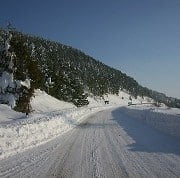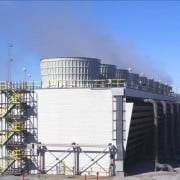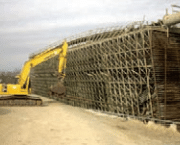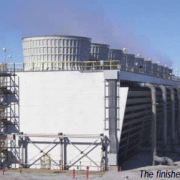Cooling Tower Fundamentals: Typical Cooling Tower Components
In our last two posts we’ve covered what makes a cooling tower work and the basic types of cooling towers. We’ve touched on some of the basic cooling tower components in our last post, but in this cooling tower fundamentals post we’d like to dig a little bit deeper into the parts that make up a cooling tower.
Fill
Most cooling towers revolve around fill, also called wet deck or surface, which is generally a PVC film type. The purpose of the fill is to maximize the contact between the air and the water, which encourages evaporation. Fill is covered in a textured patterns, usually ridges or wrinkles, so that when pieces of the fill are placed together they leave open spaces for water and air to travel. These spaces, called channels or flutes, are typically angled so that the water takes the longest possible time to travel their lengths. Individual pieces of fill are glued together to create blocks of fill which come in a variety of thicknesses and heights.
Selecting the right flute size is very important when designing a cooling tower. The smaller the flute size the higher the capacity per cubic foot, the less volume, and as a result lower costs. A marble sized flute would be more cost effective than a golf ball or baseball sized flute, and is this size is typically used in clean water application. So why use a larger sized flute? In dirty water applications, like steel mills, small flute fill would become clogged, or not work at all. A bigger, less effective fill is certainly preferable to a cooling tower that doesn’t work which is why choosing the most effective fill is vital for each cooling tower.
Bar Type Fill
Bar type fill is far less effective than film fill, but is suited to extremely dirty water applications. When bar type fill is used, water is splashed into droplets by being plashed off of splash bars throughout the tower. Although the surface area of droplets is less than when water is spread through film fill, bar type fill allows for debris to pass through the tower and is easier to clean than film fill.
Eliminators
Eliminators are used to minimize drift. Drift is any water droplets that escape into the cooling tower discharge air. Typically they provide multidirectional changes of airflow, and a well designed eliminator will greatly reduce water loss.
Spray Tree
Spray trees can take the form of either single spray heads or, when wider coverage is needed, multiple spray heads. They are used in counterflow cooling towers to distribute water as uniformly, with minimal pressure requirements, as possible over the wet deck.
Water Basins
There are two types of water basins- hot and cold. In a crossflow tower a hot water basin takes the place of the spray tree and is used to distribute the water. A distribution or hot water basin consisting of a deep pan with holes or nozzles in its bottom is located near the top of a crossflow tower. Gravity distributes the water through the nozzles uniformly across the fill material.
Cold Water Basins collect cooled water at the bottom of the tower. They are an integral part of factory assembled designs and are built in place- typically of concrete- for field erected towers.
A Make-up Valve replaces water that exits via evaporation and bleed with fresh water. It operates somewhat like the valve found in a conventional toilet tank but is bigger and more heavy duty. Like toilet tank floats, they can function mechanically or hydraulically.
There are a lot more components that go into a cooling tower than the few we’ve discussed here, including some designed for cold weather operation. If you’re interested in learning more about cooling tower components subscribe to the Cooling Towers Blog to get the next cooling tower fundamentals article, Cold Weather and Components.
















